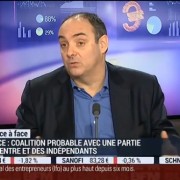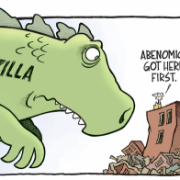Japan’s legend of three arrows
- Japanese ‘Three Arrows’ plan not the answer for sustained growth
- Economy needs to address immigration, openness
- GDP growth hampered by a lack of true reform

Japan’s rich traditions have seen it handle its period of slow growth with aplomb, but now is not the time to rely on ancient myths for guidance. Photo iStock
When Japanese prime minister Shinzo Abe introduced his « Three Arrows » economic programme in 2012/2013, it made headlines across the globe. Abe, in fact, even made the cover of Time magazine.

Source: Time
Few people, however, seem to know why the stimulus plan was named “Three Arrows”. The name, in fact, is ancient and derives from a legend that dates back to Mori Motonari (1497–1571) – a powerful feudal lord from the West Chogoku region of Japan. Motonari had three sons – Mori Takamoto, Kikkawa Motoharu, and Kobayakawa Takakage – whom he encouraged to work together for the benefit of the Mori clan.
In one instance, he is said to have handed each of his sons an arrow and asked them to snap it. After each snapped his arrow, Motonari produced three arrows and asked his sons to snap all three at once. When they were unable to do so (according to a legend still taught today), Motonari explained that one arrow could be broken easily, but three bundled arrows could not.
It’s easy to see why the legend fits with Abe’s objectives, but when we fast-forward to 2015 we can see with increasing clarity that Japan’s “plan” is really a « one arrow » strategy… and hence at risk of snapping.
Abenomics scorecard: A pass, but much improvement is needed
We are close to being able to call off the deflation risk, but that does not mean we are even halfway to the stated objective of a 2%/year inflation target. Core inflation remains weak; we saw 1.8% inflation in 2014 drop to 1.0% in 2015, and this came despite the most aggressive monetary policy ever seen in modern times (quantative and qualitative monetary easing).
The weak JPY has created a tailwind for exports, improving both trade and current accounts. It has also, however, increased domestic prices for non-exporters (and certainly for the Japanese consumer, who remains defensive).
Saxo Bank macro outlook: Japan

Source: Saxo Bank
As the table shows, we don’t expect either 2% growth nor 2% GDP advancement any time soon. We see long term maximum growth at 1%, a speed limit dictated by the lack of real reform.
Saxo Bank believes the global interest rate cycle will turn up in the next two to three quarters as move towards a secular change in the direction of higher rates. The marginal cost of capital will start rising and the business cycle will come back.
The catalyst will, as often before, be the US Federal Reserve starting its normalisation programme in September. This, however, will be supported by China’s new Silk Road and its need to use foreign exchange reserves, so we can add to this that “term premium” (or that expected inflation over time is also moving higher to more normal levels).
This cocktail will create a need for a new mandate driven by productivity, increased immigration and more competition in Japan. Buying time is close to being over.
The interest rate is already reacting higher in Japan, which is mainly due to “term premium” (but also relates to China):

The yield low for 10-year Japanese government bonds was 20 basis points in January 2015 – the yield today is 50 bps. A rise of 30 bps may not sound like much but for an economy barely growing it’s an uphill struggle which will dictate more changes for Japanese society.

This chart confirms our conclusion that deflation has been left behind, but as its elimination comes alongside weak growth and « slow-motion reform », these will very quickly function as speed limits (through driving up the financing cost) rather than as sign of improvement.
Socially, Japan has dealt extremely well with this extended period of slow growth and deflation. I think history will show how well Japan actually performed in this regard: No social unrest and a society built on inclusiveness, tradition and family values.
The way Japan responded to the tsunami will stand forever as the standard for how a nation comes together and deals with a crisis., but this stoic approach is also part of the problem. Change comes slowly and often takes the shape of « two steps forward, one step back).
Businesses remains entangled by cross holdings, zombie SMEs remains a drag on growth and politics may provide a change of faces but rarely one of direction.
Shinzo Abe was hailed as a patriot and over-promised on reforms. We now know that his « Abenomics » was not an economic “third path”, but old medicine on new bottles.
Maybe this is because Abe’s main goal was always to change the constitution –a constitution written by the Americans under General MacArthur in 1946! One can understand why Abe wants to change this, but the attempt to persuade voters by experimenting with the economy was probably a miscalculation.
The good news is that Japan Inc. is learning its lessons and is slowly becoming more open. Japanese companies are now engaged in improving shareholder value through buy-backs:

The Nikkei is performing extremely well, up 17% year-to-date… but to understand the scope of reform needed, one needs to taker a look at this final chart:
Japanese GDP in nominal terms

As we can see, Japan’s growth peaked in 1997/98, made a new high in 2006/2007, but is still below where it was in 1997!
All in all, Japan is down but not out. It will rise to the occasion and assume its proper role on the world economic scene, but I doubt the « Three Arrows » will do the job.
The problem with this legend is that it supposedly never happened. Also, the son died early – so maybe the long-term solution to Japan’s woes is to embrace the fact that a closed society was useful in the postwar era but now, in the race against machines – in the global market – the way forward is through engaging with immigration, openness, guts, and strategy.
I think Japan is ready, but first we need to break some arrows and create objectives that are based on today’s world, not legends from the 15th century.
I see USDJPY topping at 125.00/127.00, the Nikkei will be flat on the year by December and the main asset performers will be gold and silver (my target price for gold? $1,425/oz) .

Any move by Japan to descend from its castle and engage with global trends appears likely to reap large rewards. Photo: iStock
— Edited by Michael McKenna
By Steen Jakobsen, chief economist and CIO at Saxo Bank









Laisser un commentaire
Participez-vous à la discussion?N'hésitez pas à contribuer!